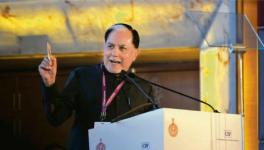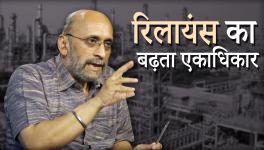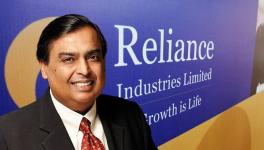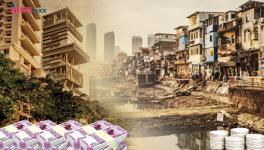A Dark Shadow Over the Festival of Lights This Year
While the top 1% Indians celebrate rising wealth due to the largesse bestowed on them by the BJP government, the Diwali mood remains dampened for most Indians struggling to make both ends meet.

The India Editor of Forbes Asia, which comes out annually with a list of the 'richie rich' of India, on the sidelines of the release of their 2018 listing of 100 richest Indians said that, “in a challenging year which saw rupee taking a tumble, the country’s 100 richest collectively managed to hold their own.” And added that “(m)oreover, new billionaires continue to be minted, which indicates that India’s entrepreneurial energy is upbeat as ever”.
This is music for the miniscule minority of Indians and quite shamelessly eulogises “entrepreneurial energy” at a time when most working adults in India have seen their earnings decline even as they work 10-12 hours, with no job security, let alone dignified wages. It is also a moot point as to how a working adult putting in 12 hours or more still manages to barely meet household needs, whereas rich Indians see their wealth grow faster amidst all round downturn for most Indians.
This rise in the wealth of rich Indians, especially the top corporate honchos, took place simultaneously as non-performing assets or bad loans of banks rose to Rs 8.41 lakh crore in December 2017, in which bad loans to industry stood at Rs 6,09,222 crore, service sector debt grew to Rs 1,10,520 crore, Rs 69,000 crore was owed by farmers, Rs 36,630 crore of retail loans and non-food credit stood at Rs 14,986 crore.
Four-and-half years of Bharatiya Janata Party (BJP) rule (May 2014 to May 2018) saw 10 Indian billionaires increase their net wealth from $84 billion in 2014 to $140 billion in 2018. Adani and Ambani among the 10 saw their wealth grow by 250% and 115%, respectively. As per Forbes India's Rich List for 2018, as many as 100 richest Indians had a combined wealth of $492 billion. According to Boston Consultancy Group, the personal wealth of 4.13 lakh Indians reached $3 trillion in 2017. Ultra High Net Worth individuals, i.e. those with wealth above $100 million, numbered 4,000. The number of next high net worth individuals, i.e those with wealth between $1 to 100 million, was 27,000 and those termed 'affluent with net wealth of $250,000 to $1 million were 3,22,000.
Credit Suisse in its Global Wealth Report 2018 claims that the richest 1% of India own 51.5% of the country’s total wealth. Which goes up to 77.4% of the total wealth of the top 10% of Indians, wheres the bottom 60% own just 4.72% of the country’s wealth. The report points out that median wealth in India per adult is estimated to be $1,289 compared with $4,263 in Brazil, $16,133 in China, $61,667 in the US and $191,453 in Australia.
In celebrating the rise in wealth of the wealthiest Indians, it is forgotten that most of the wealth cornered by the rich is a result of public funds transferred to the rich either in the form of lower direct taxes on wealth and income, or through “tax revenue foregone”, as per the Government, which is the subsidy the Government provides to the rich. The argument behind this is that big shark eating small fish is the natural order of things and that development trickles down when the rich sitting on pile of surplus, decide to invest this surplus and create job opportunities.
The history of the past 28 years of economic reform is testimony to the fact that the cornering of wealth by rich Indians has seen more joblessness, decline in net earnings of working adults, dilution and dismantling of worker’s rights which they had won over decades of struggle in the past. In short, an all-round augmentation of attack on a common person’s struggle for a life of dignity.
In January last, an International Labour Organisation (ILO) analysis showed that 77% of Indian workers, 398 million out of an estimated 535 million of Indian labour force, will have vulnerable employment by 2019. ILO said the number of unemployed was 18.3 million in 2017, 18.6 million in 2018 and will be 18.9 million in 2019. Unemployment among the 15-24 age group was high at 10% in 2014 and 10.4% in 2018 and will rise to 18.7% in 2019.
It's worth recall that most young adults crave a regular job in the government sector. Twenty four million applied for just 120,000 jobs in Railways. In 2015, as many as 23 lakh youth applied for 368 jobs of peons in Uttar Pradesh. In Haryana, 18,000 applied for 18 posts advertised by the state government.
The Narendra Modi-led BJP government had promised two crore (20 million) jobs every year against 2.48 crore (24.8 million) added annually to the labour force. With labour participation being low, the number of jobs actually created was just two million or mere 0.5% of the total number of job-seekers.
It is all this combined with the static nature of India’s human capital index (HCI)growth that India is ranked 115th among 157 countries, according to the first ever report by World Bank on HCI. Bangladesh, Nepal and Sri Lanka fare better than India in this Index.
So this Diwali, while the festive mood lies dampened for most Indians, only the top 1% of Indians will be celebrating the largesse bestowed upon them by the BJP government.
Get the latest reports & analysis with people's perspective on Protests, movements & deep analytical videos, discussions of the current affairs in your Telegram app. Subscribe to NewsClick's Telegram channel & get Real-Time updates on stories, as they get published on our website.























